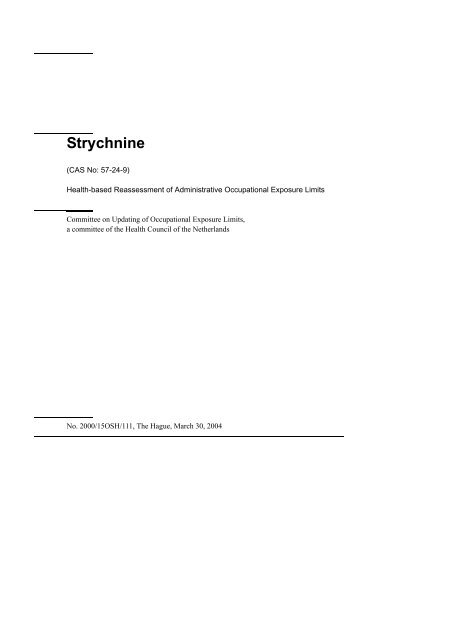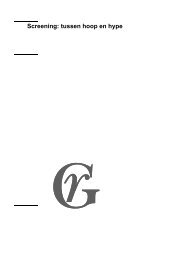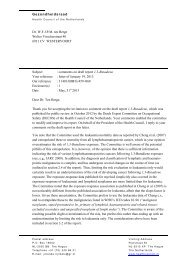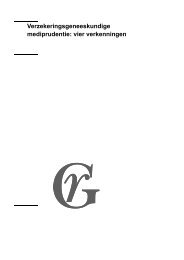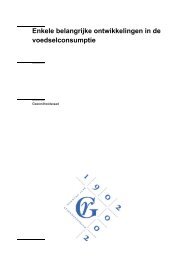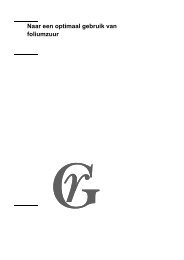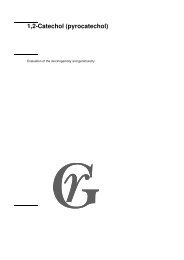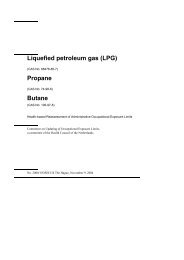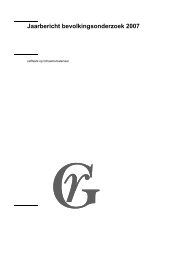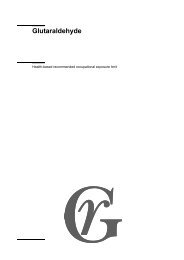Strychnine - Gezondheidsraad
Strychnine - Gezondheidsraad
Strychnine - Gezondheidsraad
Create successful ePaper yourself
Turn your PDF publications into a flip-book with our unique Google optimized e-Paper software.
<strong>Strychnine</strong><br />
(CAS No: 57-24-9)<br />
Health-based Reassessment of Administrative Occupational Exposure Limits<br />
Committee on Updating of Occupational Exposure Limits,<br />
a committee of the Health Council of the Netherlands<br />
No. 2000/15OSH/111, The Hague, March 30, 2004
Preferred citation:<br />
Health Council of the Netherlands: Committee on Updating of Occupational<br />
Exposure Limits. <strong>Strychnine</strong>; Health-based Reassessment of Administrative<br />
Occupational Exposure Limits. The Hague: Health Council of the Netherlands,<br />
2004; 2000/15OSH/111.<br />
all rights reserved
1 Introduction<br />
2 Identity<br />
The present document contains the assessment of the health hazard of strychnine<br />
by the Committee on Updating of Occupational Exposure Limits, a committee of<br />
the Health Council of the Netherlands. The first draft of this document was<br />
prepared by C de Heer, Ph.D. and H Stouten, M.Sc. (TNO Nutrition and Food<br />
Research, Zeist, the Netherlands).<br />
The evaluation of the toxicity of strychnine has been based on the review by<br />
the American Conference of Governmental Industrial Hygienists (ACGIH)<br />
(ACG91). Where relevant, the original publications were reviewed and evaluated<br />
as will be indicated in the text. In addition, in April 1997, literature was searched<br />
in the on-line databases Medline, Cancerlit, and Toxline starting from 1966,<br />
1963, and 1965, respectively, and using the following key words: strychnine and<br />
57-42-9.<br />
In March 2000, the President of the Health Council released a draft of the<br />
document for public review. The committee received comments by the following<br />
individuals and organisations: P Wardenbach, Ph.D. (Bundesanstalt für<br />
Arbeitsschutz und Arbeitsmedizin, Dortmund, Germany) and L Whitford<br />
(Health and Safety Executive, London, England). These comments were taken<br />
into account when deciding on the final version of the document.<br />
An additional search in Toxline and Medline in October 2003 did not result<br />
in information changing the committee’s conclusions.<br />
name : strychnine<br />
synonyms : strychnidin-10-one, strychinos<br />
molecular formula : C 21<br />
H 22<br />
N 2<br />
O 2<br />
structural formula: :<br />
CAS number : 57-24-9<br />
111-3 <strong>Strychnine</strong>
3 Physical and chemical properties<br />
4 Uses<br />
molecular weight : 334.40<br />
boiling point : at 101.3 kPa: decomposes (at 0.67 kPa: 270 o C)<br />
melting point : 287 o C<br />
flash point : not available<br />
vapour pressure : at 20 o C: 0 kPa<br />
solubility in water : insoluble (at 20 o C: 15 mg/100 mL)<br />
log P octanol/water<br />
: 1.93 (experimental); 1.85 (estimated)<br />
conversion factors : not applicable<br />
Data from ACG91, NLM03.<br />
<strong>Strychnine</strong> is a non-combustible, colourless, odourless, bitter-tasting crystalline<br />
solid. It is an alkaloid that is isolated from the dried seeds of Strychnos nuxvomica<br />
and other Strychnos (Loganiaceae) species (Muh86).<br />
The pH of a saturated strychnine solution is 9.5 (Muh86).<br />
<strong>Strychnine</strong> salts (nitrate, sulphate, phosphate) have been used as rodenticides, in<br />
poisoned grain and other baits for larger wild animals, and to destroy birds.<br />
Further, its use in medicine, as an adjunct in the treatment of non-ketotic<br />
hyperglycaemia, impotence, and sleep apnoea, and in veterinary medicine has<br />
been reported (ACG91, Ray91, Yam92). Nowadays, in the USA, it is used only<br />
for laboratory, research, and restricted (i.e., only for below-ground, bait<br />
applications to control pocket gophers) pesticide purposes (EPA96, Ros00).<br />
<strong>Strychnine</strong> is reported to have been found as an adulterant in street drugs such as<br />
amphetamines, heroin, and cocaine and as trace ingredient in certain<br />
homeopathic remedies (Flo99, Woo02).<br />
According to the database of the Dutch Pesticide Authorisation Board<br />
(CTB)*, strychnine is at present not permitted in the Netherlands for use as an<br />
active ingredient in pesticides. The ‘Geneesmiddelen Repertorium’, an overview<br />
of information on pharmaceutical specialties registered by the Dutch Medicines<br />
Evaluation Board, did not list strychnine-containing products**.<br />
* At: http://www.ctb-wageningen.nl.<br />
** At: http://www.geneesmiddelenrepertorium.org.<br />
111-4 Health-based Reassessment of Administrative Occupational Exposure Limits
5 Biotransformation and kinetics<br />
While the serum of healthy subjects does not contain strychnine in detectable<br />
amounts, significant, endogenous amounts were found in patients with epilepsy,<br />
Parkinson’s disease, and manic-depressive psychosis (Kum02).<br />
Absorption<br />
<strong>Strychnine</strong> is rapidly absorbed from the gastrointestinal tract, mucous<br />
membranes, and parental sites of injection. Ingested strychnine is absorbed<br />
primarily from the intestine (ACG91, NLM03). Dermal absorption may occur as<br />
well as was indicated by a case of non-fatal poisoning of a woman wiping up a<br />
strychnine spill with a cloth soaked in a diluted sodium hypochlorite solution<br />
(which converted the strychnine salt into the free base that is more efficiently<br />
absorbed through the skin) (Gre01).<br />
Distribution<br />
Once absorbed, strychnine rapidly leaves the blood stream. There is very little<br />
protein binding. In poisonings, the blood will usually contain more than 2 mg/L,<br />
the liver more than 4 mg/kg (McB73). At autopsy following fatal poisoning of<br />
humans and dogs, the highest concentrations were found in the blood, liver, bile,<br />
kidney, and stomach, with much lower levels detected in muscle and brain<br />
(Bla84, Niy73, Ray91). In cases of fatal ingestion, strychnine was detected in<br />
blood (at levels ranging from 0.4-61 mg/L), brain (0.5-66 mg/kg), spinal cord<br />
(0.1-1.9 mg/L), kidney (0.1-106 mg/kg), liver (0.3-515 mg/kg), bile (9-11 mg/L),<br />
spleen (11.8 mg/kg), skeletal muscle (trace-2.3 mg/kg), urine (0.5-33 mg/L), and<br />
stomach content (1-3000 mg) (Cin99, Mar00, Oli79, Ros00). Generally,<br />
although strychnine acts principally on the spinal cord, it is not concentrated<br />
there. <strong>Strychnine</strong> was detected in blood, urine, and gastric contents following<br />
non-fatal ingestion (Ray91).<br />
Analysis of strychnine levels in stomach contents and liver tissue from 44<br />
dogs that died after manifesting typical signs of strychnine poisoning showed<br />
that these levels were not related to each other (Hat68).<br />
111-5 <strong>Strychnine</strong>
Metabolism<br />
<strong>Strychnine</strong> metabolism occurs largely by the hepatic microsomal enzyme<br />
system, where up to 80% of the dose is oxidised. Biotransformation rates in liver<br />
microsomal preparations of rats were 64-144 µg/g liver/hour, whereas in guinea<br />
pig liver slices, rates of 387-649 µg/g liver/hour have been reported (Ray91). In<br />
rats given strychnine in the drinking water at doses of 0.15 mg/mL for 5 days,<br />
profound induction of cytochrome P450 isoenzymes CYP2B1 and CYP2B2 was<br />
found. The maximal increase was attained after 3 days of administration. In<br />
addition, strychnine induced some glutathione S-transferase and UDPglucuronosyltransferase<br />
activities (Fuj94).<br />
Urinary metabolites identified in vivo in rats after subcutaneous injection of<br />
doses of strychnine of 0.5 mg/kg bw were strychnine N-oxide (M-1), 21α,22α−<br />
dihydroxy-22-hydrostrychnine (M-11), 21α,22β-dihydroxy-22-hydrostrychnine<br />
(M-12), 2-hydroxystrychnine (M-2), strychnine 21,22-epoxide (M-3), and 16-<br />
hydroxystrychnine (M-7) (see Annex I). The major metabolite of strychnine in<br />
vivo in rats was M-3 (Ogu89).<br />
The in vitro metabolism of strychnine was studied in 9000g supernatant<br />
fractions of rat and rabbit livers. The metabolism was markedly inhibited by<br />
cytochrome P450 inhibitors, but only slightly by a microsomal FAD-containing<br />
monooxygenase inhibitor, methimazole. Five metabolites formed in vitro with<br />
rabbit liver were identified as 2-hydroxystrychnine (M-2), strychnine N-oxide<br />
(M-1), 21α,22α -dihydroxy-22-hydrostrychnine (M-11), strychnine 21,22-<br />
epoxide (M-3), and 11,12-dehydrostrychnine (M-13). Although M-2 was the<br />
major of the characterised metabolites (15%), whereas all other metabolites<br />
accounted for less than 1%, this may be of limited relevance because almost 85%<br />
of metabolites were not identified (Mis85).<br />
Primary metabolism of strychnine was also examined in vitro in liver<br />
microsomes of mice, rats, guinea pigs, rabbits, and dogs. Six out of 8 metabolites<br />
were identified, i.e., strychnine N-oxide (M-1), 2-hydroxystrychnine (M-2),<br />
strychnine 21,22-epoxide (M-3), 22-hydroxystrychnine (M-5), 16-<br />
hydroxystrychnine (M-7), and 18-oxostrychnine (M-8) (Tan90, Tan91a).<br />
Significant differences in metabolic profiles were observed among the above<br />
species, although the indicated metabolites were detected in all species (with the<br />
exception of M-3 in rabbits). M-7 was the main metabolite in mice and rats, M-2<br />
in guinea pigs and rabbits, and M-1 in dogs. M-3 and M-8 were minor<br />
metabolites (Tan90). This latter finding contrasts with the in vivo data obtained<br />
in rats, where M3 was identified as a major metabolite (Ogu89). The metabolic<br />
activity in guinea pig liver microsomes was much higher than those of other<br />
111-6 Health-based Reassessment of Administrative Occupational Exposure Limits
species. Except for dogs, there seemed to be a fairly good inverse correlation<br />
between the observed metabolic activity and the acute toxicity data on strychnine<br />
reported elsewhere (Tan90).<br />
The N-oxide metabolite (M-1) can readily be reduced to the parent<br />
compound and M-7 by human intestinal flora under anaerobic conditions<br />
(ElM93).<br />
Animals treated with phenobarbital or other microsomal enzyme inducers<br />
metabolised strychnine faster than untreated animals. Phenobarbital treatment<br />
resulted in increased formation of especially M-2 and M-1 strychnine<br />
metabolites, but also of other oxidative metabolites. Similar increases, albeit to a<br />
lesser extent, were observed after 3-methylcholanthrene treatment (Tan91b).<br />
The metabolites did not appear to contribute to the toxicity of strychnine but<br />
to detoxification (Ogu89, Tan90).<br />
Female rats showed more pronounced responses to strychnine than males.<br />
This sex difference was due to a difference in the rate of metabolism of<br />
strychnine in the liver, as male rats oxidised strychnine about 2.5 times faster<br />
than female rats; castration abolished the observed difference in metabolism and<br />
toxicity. In mice, no clear sex differences were noted in metabolism of<br />
strychnine (Kat74).<br />
A metabolism scheme is presented in Figure 1 (Annex I).<br />
Excretion<br />
The urinary and faecal excretions of radioactivity in rats subcutaneously dosed<br />
with [ 3 H]-strychnine at 0.5 mg/kg bw, were approximately 30% and 65% of the<br />
dose in 7 days, respectively. Almost 80% of the radioactivity was excreted<br />
within 24 hours. Approximately 6% and 3% were excreted unchanged in urine<br />
and faeces, respectively (Ogu89).<br />
In humans, a variable amount (1-20%) was excreted unchanged in the urine,<br />
depending on the amount ingested (Hei92, Muh86, Sga73, Smi90, Yam92).<br />
Seventy percent of the excretion of the unchanged parent compound occurs in<br />
the first 6 hours. Trace concentrations persist in urine for up to 5 days after<br />
ingestion (ACG91, Ray91). <strong>Strychnine</strong> is very stable and may be found in<br />
cadavers exhumed many years after death (Muh86).<br />
At 1 hour after fatal ingestion, no strychnine was detected in urine. Serial<br />
serum strychnine levels detected at 0.5, 8, 22, 35, and 43 hours decreased from<br />
3.8 to less than 0.1 mg/L, and this was best described by a (non-linear) single<br />
compartment model with saturating (Michaelis-Menten) elimination. Assuming<br />
100% absorption, the following parameters were calculated: absorption rate<br />
111-7 <strong>Strychnine</strong>
constant (k a<br />
=2.68/h), absorption half-life (T ½ a<br />
=15.5 min), maximum elimination<br />
rate (V max<br />
=3.71 mg/kg/h), Michaelis constant (k m<br />
=1.46 mg/L), and volume of<br />
distribution (V d<br />
=13 L/kg). When absorption is less complete, then V d<br />
would be<br />
proportionally less (Hei92). Two other reports described a first-order kinetics of<br />
elimination from the blood in humans after oral ingestion of strychnine (Edm86,<br />
Pal97). In the first study, 19 serial serum samples were obtained from 4 to 53<br />
hours post-ingestion. The elimination after oral ingestion (peak strychnine level<br />
1.6 mg/L at 4-hour post-ingestion) was found to be consistent with first-order<br />
kinetics, with an elimination half-life of 10 h (Edm86). In the second study, 18<br />
serial serum samples were obtained from 20 minutes to 51 hours post-ingestion.<br />
The highest serum strychnine concentration was 2.1 mg/L and occurred 3 hours<br />
after ingestion. Disappearance from the blood was best described by first-order<br />
kinetics, with an elimination half-life of 15.9 hours (Pal97).<br />
Together, the results indicate that strychnine is readily metabolised and rapidly<br />
excreted into the urine and faeces (Ogu89).<br />
6 Effects and mechanism of action<br />
Human data<br />
<strong>Strychnine</strong> produces excitation at all levels of the nervous system by selectively<br />
and competitively blocking the post-synaptic action of the inhibitory<br />
neurotransmitter glycine. This leads to increased neuronal activity such that any<br />
sensory stimuli may produce exaggerated reflex arcs, leading to muscular<br />
spasms, convulsions, or respiratory muscle paralysis (Hei92, Yam92). Early<br />
symptoms of poisoning occurring within 15-30 min include tremors, slight<br />
twitching, and stiffness of face and legs. Painful convulsions subsequently<br />
develop. All sensation is heightened. Convulsive seizures become more frequent<br />
and death eventually occurs from exhaustion or anoxia during a tetanic seizure.<br />
Few patients survive more than 5 episodes of convulsions with respiratory arrest<br />
causing death. Lactic acidosis, renal failure, hyperthermia, and rhabdomyolysis<br />
occur as secondary effects arising from the severe spasms. In addition, exposure<br />
to strychnine may lead to photophobia, muscular rigidity, stiffness in joints,<br />
hysteria, myalgia, lassitude, and headache. Finally, the occurrence of abnormal<br />
eye movements (horizontal and vertical nystagmus) has been reported (ACG91,<br />
Bla82, Edm86, Gon90, Hei92, Nis95, Osw77, Per85, Ric94, Smi90, Spa90,<br />
Tei70, Yam92).<br />
111-8 Health-based Reassessment of Administrative Occupational Exposure Limits
In human beings, 15-30 mg of strychnine usually proves lethal, but deaths<br />
have been reported from as little as 5-10 mg, and survival after a dose of 3750<br />
mg (ACG91, Niy73, Ray91, Ric94). Children may be more susceptible to<br />
strychnine than adults (ACG91, Ray91). The latter observation contrasts with<br />
animal data (Hun89). There is a wide individual variability in the manifestations<br />
of poisoning, as both people surviving doses as large as 3.75 g and people dying<br />
within 15 minutes after ingestion of 3.4 g (with no signs of the classic spasms or<br />
convulsions) have been reported (ACG91).<br />
In accidental, suicidal, or homicidal poisonings with strychnine, toxic doses<br />
usually produce some muscular tightness and fasciculations. Movements may be<br />
abrupt and vomiting may occur. With a fatal dose, only 10-20 minutes elapse<br />
from the time of ingestion to the onset of symptoms, and death occurs in about<br />
40 minutes (DiP81). Within 15-30 minutes after ingestion, generalised<br />
convulsions occur that may be clonic initially but quickly become tonic. Patients<br />
given doses of 5 to 7 mg reported a tightness of their muscles, especially those of<br />
the neck and jaws; individual muscles, especially those of the little fingers, may<br />
twitch (Ray91).<br />
Pathological findings are entirely non-specific. They usually consist of<br />
petechial haemorrhages and congestion of the organs, indicating combined<br />
action of severe convulsions and anoxia (Per85, Ray91).<br />
At autopsy, necrosis was observed throughout the brain probably as a result<br />
of hypoxic damage (Hei92). Histologically, a human autopsy liver containing<br />
108 mg/kg strychnine showed an intense formation by lipofuscin pigment<br />
throughout the liver parenchyma together with small-droplet hyaline change. It<br />
was suggested that high levels of strychnine in the liver may result in death<br />
without evidence of physical struggle, whereas low levels result in a delayed<br />
death probably accompanied by the physical responses commonly attributed to<br />
strychnine poisoning (Oli79).<br />
Full recovery from strychnine poisoning was observed after 7-10 days<br />
(Nis95). In contrast, after recovery from strychnine ingestion, other patients<br />
suffered from 70% loss of visual acuity together with a left hemiparesia. This is<br />
considered secondary to severe acidaemia and prolonged hypoxia (Gon90).<br />
Animal data<br />
Irritation of tissues and sensitisation was stated not to be associated with<br />
strychnine (Ray91), but no data were available. Oral LD 50<br />
values reported in rats<br />
ranged from 2.35 to 16 mg/kg bw (ACG91, Ric94). In mice and dogs, oral LD 50<br />
values were 2 and 0.5-1.1 mg/kg bw, respectively (Ric94, Sga73).<br />
111-9 <strong>Strychnine</strong>
Intraperitoneal LD 50<br />
values were 0.9-2.8 mg/kg bw in rats and 1.4-1.8 mg/kg<br />
bw in mice (ACG91, Lam68). There was no difference in intraperitoneal toxicity<br />
between the sulphate, benzoate, salicylate, and o-nitrobenzoate expressed in<br />
terms of their alkaloid content (Ray91). Subcutaneous LD 50<br />
values of 1.2-4.0,<br />
0.47, and 0.46 mg/kg bw have been reported for rats, mice, and dogs,<br />
respectively. <strong>Strychnine</strong> was more toxic to female than to male rats after oral,<br />
subcutaneous, or intraperitoneal administration, a difference that has been<br />
attributed to a higher rate of metabolism in males. Intravenous LD 50<br />
values were<br />
as low as 0.57-0.96 and 0.39 mg/kg bw in rats and guinea pigs, respectively<br />
(ACG91, NLM03, Ray91, Ric94, Sei82).<br />
The circadian toxicity of strychnine (sulphate) was evaluated at 6-hour<br />
intervals in male Ha/ICR mice, previously conditioned on a 12-hour light (from<br />
08.00 to 20.00 h) and 12-hour darkness schedule in a controlled environment.<br />
The highest acute lethality was observed in animals exposed during the light<br />
phase (at 18.00 h), whereas the lowest toxicity was observed in animals exposed<br />
during the dark phase (dose resulting in 50% acute lethality 1.57±0.12 and<br />
1.84±0.20 mg/kg bw, respectively) (Pie77).<br />
In vitro [ 3 H]-strychnine binding was decreased by 38 and 34% in the medulla<br />
and spinal cord, respectively, of 24-month-old rats compared to 2-month-old<br />
rats. Comparison of these age groups after intraperitoneal injection of strychnine<br />
of 1.75 mg/kg bw showed that senescent animals had a higher incidence of<br />
seizures and mortality (with faster onset times) compared to young animals<br />
(seizures 6/8 vs. 0/8, mortality 5/8 vs. 0/8). These differences may be attributed<br />
to age-related changes in glycinergic neurotransmission (Hun89). The findings<br />
contrast with data on strychnine poisoning in humans.<br />
The ED 50<br />
* for convulsions is remarkably close to the LD 50<br />
. In male COBS-<br />
CDI mice, the intraperitoneal LD 50<br />
was 1.34 mg/kg, whereas the intraperitoneal<br />
ED 50<br />
for both clonic and tonic convulsions was 1.24 mg/kg bw (Mac77).<br />
Following single subcutaneous administration of strychnine doses of 0.75, 1.25,<br />
and 1.50 mg/kg bw to adult CBA mice, convulsions developed in 8/20, 19/20,<br />
and 21/21 animals, respectively, with an average latency time ranging from 6.1<br />
to 10.3 minutes. Death occurred in 4/20, 17/20, and 19/21 mice, respectively. No<br />
sex difference was observed (Man87). <strong>Strychnine</strong>, intraperitoneally administered<br />
at 0.5-4 mg/kg bw, dose-dependently produced tonic seizures in male ‘albino<br />
mice’. The strychnine seizures in mice were potentiated by enhancement of<br />
noradrenergic neurotransmission (Ama94).<br />
* ED 50<br />
: dose at which a described effect is found in 50% of the exposed animals or at which the effect is changed by<br />
up to 50% compared to the control value.<br />
111-10 Health-based Reassessment of Administrative Occupational Exposure Limits
The convulsing action of strychnine (0.25-4 mg/kg bw, intraperitoneal) was<br />
studied in 3- to 25-day-old rats. Generalised tonic-clonic seizures occurred in all<br />
age groups. The convulsing effects increased from day 3 to 18, and decreased<br />
again from day 25, as indicated by the incidence and latencies of seizures. Lethal<br />
effects did not occur before day 12 (Kub95).<br />
In rabbits, strychnine produces a continuous discharge of synchronous waves<br />
at 30 c/sec at the level of the spinal cord, the cerebellum, and the midbrain; only<br />
desynchronisation can be noticed in cortical leads (Lon83). Rabbits,<br />
anaesthetised with urethane and administered doses of strychnine of 400 µg/kg<br />
bw (route not specified), developed tonic-clonic convulsions. Afterwards, onethird<br />
of the animals displayed irreversible paralysis of the hind limbs due to<br />
transverse lesions. Microscopically, only limited degenerative changes were<br />
observed at 100 days after exposure (Jäg66).<br />
Injection of strychnine into the brain of cats caused convulsing effects in a<br />
laminar-specific manner. No effects of strychnine were noted in rats attempting<br />
to solve a stressful task in either terms of probability or rapidity. Intravenous<br />
administration to rats inhibited bethanechol-stimulated secretion in the stomach<br />
and was associated with convulsions. Inhibition did not occur in d-tubocurarineparalysed<br />
animals (Ric94). In cats, the strychnine-sensitive synapses appeared to<br />
be limited only to a subset of cortical neurons driven by somatic inputs (Tre88).<br />
In anaesthetised and paralysed dogs, administration of strychnine in<br />
cumulative doses of up to 0.1 to 0.2 mg/kg bw caused significant pressor, as well<br />
as positive inotropic and chronotropic effects on the heart, which were abolished<br />
by adrenergic blocking agents. The cardiovascular responses possibly were<br />
elicited by a central mechanism in contrast to the peripheral inhibitory action of<br />
strychnine on the sympathetic system (Sof76).<br />
Autopsy findings were usually entirely non-specific, reflecting only the<br />
presence of violent convulsions and anoxia. Congestion and small haemorrhages<br />
may be found in the brain and sometimes in the viscera (Ray91). Convulsive<br />
doses of strychnine (2.5 mg/kg bw strychnine sulphate, subcutaneously) caused a<br />
marked depletion of the neurosecretory material from the hypothalamic nuclei as<br />
well as from the neurohypophysis (Vij72).<br />
The biochemical mechanism of strychine poisoning is dependent upon<br />
inhibition of outward sodium ion flux in spinal nerves, manifest as increased<br />
cerebrospinal excitability, tetanic contractions of the diaphragm and striated<br />
muscles, sympathetic discharge (accounting for the tachycardia and<br />
hypertension), and death in respiratory arrest (ACG91).<br />
Individual subcutaneous injection of dogs and guinea pigs with strychnine at<br />
0.25 to 0.35 mg/kg bw every 3 to 7 days occasionally produced no increase of<br />
111-11 <strong>Strychnine</strong>
eflexes but generally produced increased reflexes or tonic-clonic variable<br />
convulsions (ACG91).<br />
Based on maximally tolerated single doses, determined in a pilot experiment,<br />
of 8 and 2.5 mg/kg bw/day for males and females, respectively, male and female<br />
Sprague-Dawley/SIV rats (n=12/sex/group) were orally (gavage) exposed to<br />
strychnine (given as a 2% solution of strychnine hydrochloride in distilled water)<br />
at doses of 0, 5, and 10 or 0 and 2,5 mg/kg bw, respectively, for 28 days. Apart<br />
from haematological, blood chemistry, urinalysis, ophthalmological,<br />
macroscopic, and microscopic investigations, animals were submitted to a<br />
rotating rod test and an electrocardiography before and during treatment. Ten to<br />
20 minutes after each administration, the animals showed increased muscle tone<br />
and slight tremors gradually subsiding during the following hour. Mortality<br />
occurred in 1/12 and 5/12 male rats of the low- and high-dose group,<br />
respectively, and in 1/12 females. Animals died within 1/2 to 6 hours following<br />
administration showing tonic muscle contractions and respiratory paralysis and,<br />
at autopsy, pulmonary oedema and cyanosis. Comparison with control animals<br />
did not show treatment-related changes in body weight gains and food and water<br />
consumption or in any of the investigations performed (Sei82).<br />
The committee did not find further data on repeated-dose toxicity, including<br />
carcinogenicity or reproduction toxicity, of strychnine.<br />
Mutagenicity and genotoxicity<br />
<strong>Strychnine</strong> was stated to be negative in the gene mutation assay using S.<br />
typhimurium strains TA98, TA100, TA1537, and TA1538 (no reference or<br />
details presented (Wür91). It induced a dose-dependent increase in the frequency<br />
of Trp + genetic duplications in S. typhimurium strain TS1121 (aroC321 hisG46),<br />
with very high frequencies at high doses. Doses that were recombinagenic did<br />
not cause increases in the frequency of base-pair substitution or frameshift<br />
mutations in the hisG46, hisD3052, or hisC3076 alleles in the same strain<br />
(Hof87). <strong>Strychnine</strong> was stated to have induced mitotic recombination and/or<br />
gene conversion in S. cerevisiae (unpublished results; no details presented)<br />
(Wür86).<br />
<strong>Strychnine</strong> did not induce sex-linked recessive lethal mutations or<br />
clastogenic effects in D. melanogaster germ cells (unpublished results; no details<br />
presented) (Wür86). In somatic Drosophila cells, it was negative in the whiteivory<br />
reversion assay when tested at one single dose of 1.14 mM (Wür91) while<br />
111-12 Health-based Reassessment of Administrative Occupational Exposure Limits
positive results were obtained in he wing-spot assay in DNA repair-proficient<br />
larvae (Wür86).<br />
These results suggest that strychnine may be specifically recombinagenic,<br />
but not mutagenic.<br />
7 Existing guidelines<br />
The current administrative occupational exposure limit (MAC) for strychnine in<br />
the Netherlands is 0.15 mg/m 3 , 8-hour TWA.<br />
Existing occupational exposure limits for strychnine in some European<br />
countries and in the USA are summarised in Annex II.<br />
8 Assessment of health hazard<br />
<strong>Strychnine</strong> is rapidly absorbed from the gastrointestinal tract and mucous<br />
membranes. It concentrates primarily in the liver, where it is detoxified by<br />
oxidation by hepatic microsomal enzymes. Elimination from the blood is<br />
probably best described by first-order kinetics with an elimination half-life of 10-<br />
16 hours. It is rapidly excreted in urine and faeces (80% as metabolites, 1-20% as<br />
parent compound).<br />
There are no human data from which an inhalation exposure concentrationeffect<br />
relation can be estimated for strychnine. There are no data on irritation and<br />
sensitisation.<br />
<strong>Strychnine</strong> is an acute convulsant poison acting at the level of the spinal cord<br />
in man and animals, but there is no evidence for cumulative toxicity. Doses as<br />
low as 5 mg have been fatal for man. The committee did not find data on acute<br />
toxicity after inhalation or dermal exposure. Acute lethal toxicity data from other<br />
routes indicate that strychnine is a very toxic compound. Oral LD 50<br />
values were<br />
2.35-16, 2, and 0.5-1.1 mg/kg bw in rats, mice, and dogs, respectively. Values<br />
found in rats, mice, dogs, or guinea pigs following intraperitoneal, subcutaneous,<br />
or intravenous administration were 0.9-2.8, ca. 0.5-4.0, and ca. 0.4-1 mg/kg bw,<br />
respectively. <strong>Strychnine</strong> was more toxic to female than to male rats after oral,<br />
subcutaneous, or intraperitoneal administration, a difference that has been<br />
attributed to a higher rate of metabolism in males.<br />
Administration via the drinking water of strychnine doses of 2.5<br />
mg/kg bw/day to female and of 5 and 10 mg/kg bw to male Sprague-Dawley rats<br />
caused transient increased muscle tone and slight tremors 10-20 minutes after<br />
each administration. Mortality occurred in 1/12 female and in 1/12 low-dose and<br />
5/12 high-dose male rats, animals showing tonic muscle contractions, respiratory<br />
111-13 <strong>Strychnine</strong>
paralysis, pulmonary oedema, and cyanosis. In the surviving animals, no changes<br />
were seen at haematological, blood chemistry, urinalysis, ophthalmological,<br />
electrocariographic, macroscopic, and microscopic investigations and in a<br />
rotating rod test.<br />
<strong>Strychnine</strong> induced genetic duplications in S. typhimurium, in D.<br />
melanogaster, and in yeast. It was negative in the D. melanogaster white-ivory<br />
reversion test. It was negative in mutagenicity assays in S. typhimurium. These<br />
results suggest that strychnine may be specifically recombinagenic, but not<br />
mutagenic.<br />
There are no further data available on repeated-dose toxicity of strychnine,<br />
including carcinogenicity and reproduction toxicity.<br />
The committee considers the database on strychnine too poor to justify<br />
recommendation of a health-based occupational exposure limit.<br />
In view of the occurrence of deaths in humans at doses as low as 5 mg and the<br />
present MAC-value of 0.15 mg/m 3 , 8-hour TWA, (equivalent to a dose of 1.5 mg<br />
per day for workers, assuming a respiratory volume of 10 m 3 per working day),<br />
the committee concludes that the present MAC-value may be too high.<br />
References<br />
ACG91 American Conference of Governmental Industrial Hygienists (ACGIH). Documentation of the<br />
threshold limit values and biological exposure indices. 6th ed. Cincinnati OH, USA; ACGIH ® , Inc,<br />
1991: 1433-5.<br />
ACG03a American Conference of Governmental Industrial Hygienists (ACGIH). Guide to occupational<br />
exposure values - 2003. Cincinnati OH, USA: ACGIH ® , Inc, 2003: 111.<br />
ACG03b American Conference of Governmental Industrial Hygienists (ACGIH). 2003 TLVs ® and BEIs ®<br />
based on the documentation of the Threshold Limit Values for chemical substances and physical<br />
agents & Biological Exposure Indices. Cincinnati OH, USA: ACGIH ® , Inc, 2003: 48.<br />
Ama94 Amabeoku G, Chandomba R. <strong>Strychnine</strong>-induced seizures in mice: the role of noradrenaline. Prog<br />
Neuropsychopharmacol Biol Psychiatry 1994; 18: 753-63.<br />
Arb02 Arbejdstilsynet. Grænseværdier for stoffer og materialer. Copenhagen, Denmark: Arbejdstilsynet,<br />
2002: 29 (At-vejledning C.0.1).<br />
Bla82 Blain PG, Nightingale S, Stoddart JC. <strong>Strychnine</strong> poisoning: abnormal eye movements. J Toxicol<br />
Clin Toxicol 1982; 19: 215-7.<br />
Bla84 Blakley BR. Epidemiologic and diagnostic considerations of strychnine poisoning in the dog. J Am<br />
Vet Med Assoc 1984; 1: 46-7.<br />
111-14 Health-based Reassessment of Administrative Occupational Exposure Limits
Cin99 Cingolani M, Froldi R, Mencarelli, et al. Analytical detection and quantitation of strychnine in<br />
chemically fixed organ tissues. J Anal Toxicol 1999; 23: 219-21.<br />
DFG03 Deutsche Forschungsgemeinschaft (DFG): Commission for the Investigation of Health Hazards of<br />
Chemical Compounds in the Work Area. List of MAK and BAT values 2003. Maximum<br />
concentrations and biological tolerance values at the workplace. Weinheim, FRG: Wiley-VCH<br />
Verlag GmbH & Co. KGaA, 2003; rep no 39.<br />
DiP81 DiPalma JR. Human toxicity from rat poisons. Am Fam Physician 1981; 24: 186-9.<br />
EC03 European Commission: Directorate General of Employment and Social Affairs. Occupational<br />
exposure limits (OELs); http://europe.eu.int/comm/employment_social/h&s/areas/oels_en.htm.<br />
Edm86 Edmunds M, Sheenan TMT, Van't Hoff W. <strong>Strychnine</strong> poisoning: clinical and toxicological<br />
observations on a non-fatal case. Clin Toxicol 1986; 24: 245-5.<br />
ElM93 El-Mekkawy S, Meselhy MR, Kawata Y, et al. Metabolism of strychnine N-oxide and brucine N-<br />
oxide by human intestinal bacteria. Planta Med 1993; 59: 347-50.<br />
EPA96 US Environmental Protection Agency (EPA). R.E.D. Facts. <strong>Strychnine</strong>. Washington DC, USA: US<br />
Environmental Protection Agency, Office of Pesticide Programs, Special Review and Reregistration<br />
Division, 1996; http://www.epa.gov/oppsrrd1/REDs/facsheets/3133fact.pdf.<br />
Flo99 Flood RG. <strong>Strychnine</strong> poisoning. Pediatr Emerg Care 1999; 15: 286-7.<br />
Fuj94 Fujisaki H, Mise M, Ishii Y, et al. <strong>Strychnine</strong> and brucine as the potent inducers of drug metabolizing<br />
enzymes in rat liver: different profiles from phenobarbital on the induction of cytochrome P450 and<br />
UDP-glucuronosyltransferase. J Pharmacol Exp Ther 1994; 268: 1024-31.<br />
Gon90 Gonzalez M, Guillaume JE, Laloux P, et al. <strong>Strychnine</strong> poisoning, hypoxic damage, severe acidosis:<br />
a case report. Acta Clin Belg Suppl 1990; 13: 94-5.<br />
Gre01 Greene R, Meatherall R. Dermal exposure to strychnine. J Anal Toxicol 2001; 25: 344-7.<br />
Hat68 Hatch RC, Funnell HS. <strong>Strychnine</strong> levels in tissues and stomach contents of poisoned dogs: an eleven<br />
year survey. Can Vet J 1968; 9: 161-4.<br />
Hei92 Heiser JM, Daya MR, Magnussen AR, et al. Massive strychnine intoxication: serial blood levels in a<br />
fatal case. Clin Toxicol 1992; 30: 269-83.<br />
Hof87 Hoffmann GR, Sprague KM, Wrobel JA, et al. A recombinagenic effect of strychnine in Salmonella<br />
typhimurium. Environ Mol Mutagen 1987; 10: 27-33.<br />
HSE02 Health and Safety Executive (HSE). EH40/2002. Occupational Exposure Limits 2002. Sudbury<br />
(Suffolk), UK: HSE Books, 2002:<br />
Hun89 Hunter C, Chung E, Van Woert MH. Age-dependent changes in brain glycine concentration and<br />
strychnine-induced seizures in the rat. Brain Res 1989; 482: 247-51.<br />
Jäg66 Jäger J. Traumatisch bedingte Rückenmarkveränderungen bei Kaninchen nach Strychnin.<br />
Gegenbaurs Morphol Jahrb 1966; 109: 243-4.<br />
Kat74 Kato R. Sex-related differences in drug metabolism. Drug Metab Rev 1974; 3: 1-32.<br />
Kub95 Kubová H, Mareš P. Different postnatal development of convulsions and lethality induced by<br />
strychnine in rats. Pharmacol Toxicol 1995; 77: 219-24.<br />
111-15 <strong>Strychnine</strong>
Kum02 Kurup RK, Kurup PA. Endogenous strychnine: description of hypo- and hyperstrychninergic state in<br />
relation to neuropsychiatric diseases. Int J Neurosci 2002; 112: 1229-41.<br />
Lam68 Lamanna C, Hart ER. Relationship of lethal toxic dose to body weight of the mouse. Toxicol Appl<br />
Pharmacol 1968; 13: 307-15.<br />
Lon83 Longo VG, Massotti M, Sagratella S. Convulsant drugs and changes in the electrical activity of the<br />
brain: an investigation of the effects of opioids on chemoconvulsions. Prog Clin Biol Res 1983; 124:<br />
121-7.<br />
Mac77 Mackerer CR, Kochman RL, Shen TF, et al. The binding of strychnine and strychnine analogs to<br />
synaptic membranes of rat brainstem and spinal cord. J Pharmacol Exp Ther 1977; 201: 326-31.<br />
Man87 Manev H, Peričić D, Anić-Stojiljković S. Sex differences in the sensitivity of CBA mice to<br />
convulsions induced by GABA antagonists are age-dependent. Psychopharmacology 1987; 91: 226-<br />
9.<br />
Mar00 Marques EP, Gil F, Proença P, et al. Analytical method for the determination of strychnine in tissues<br />
by gas chromatography/mass spectrometry: two case reports. Forensic Sci Int 2000: 110: 145-52.<br />
McB73 McBay AJ. Toxicological findings in fatal poisonings. Clin Chem 1973; 19: 361-5.<br />
Mis85 Mishima M, Tanimoto Y, Oguri K, et al. Metabolism of strychnine in vitro. Drug Metab Dispos<br />
1985; 13: 716-21.<br />
Muh86 Muhtadi FJ, Hifnawy MS. <strong>Strychnine</strong>. Analytical Profiles of Drug Substances 1986; 15: 563-646.<br />
NIO97 National Institute of Occupational Safety and Health (NIOSH). Registry of Toxic Effects of<br />
Chemical Substances (RTECS) [CD-ROM, issue April 1997. SilverPlatter International, 1997 (last<br />
update strychnine file: April 1997).<br />
Nis95 Nishiyama T, Nagase M. <strong>Strychnine</strong> poisoning: natural course of a nonfatal case. Am J Emerg Med<br />
1995; 13: 172-3.<br />
Niy73 Niyogi SK. Drug levels in cases of poisoning. Forensic Sci 1973; 2: 67-98.<br />
NLM03 US National Library of Medicine (NLM), ed. <strong>Strychnine</strong>. In: Hazardous Substances Data Bank<br />
(HSDB) (last revision date strychnine file: January 2003; last review date: September 1999); http://<br />
toxnet.nlm.nih.gov.<br />
Ogu89 Oguri K, Tanimoto Y, Mishima M, et al. Metabolic fate of strychnine in rats. Xenobiotica 1989; 19:<br />
171-8.<br />
Oli79 Oliver JS, Smith H, Watson AA. Poisoning by strychnine. Med Sci Law 1979; 19: 134-7.<br />
Osw77 Osweiler GD. <strong>Strychnine</strong> poisoning. Curr Vet Ther 1977; 6: 115-7.<br />
Pal97 Palatnick, Meatherall R, Sitar D, et al. Toxicokinetics of acute strychnine poisoning. Clin Toxicol<br />
1997; 35: 617-20.<br />
Per85 Perper JA. Fatal strychnine poisoning - a case report and review of the literature. J Forensic Sci 1985;<br />
30: 1248-55.<br />
Pie77 Piepho RW, Friedman AH. Chronopharmacology of strychnine and allylglycine in the mouse. Clin<br />
Exp Pharmacol Physiol 1977; 4: 263-6.<br />
111-16 Health-based Reassessment of Administrative Occupational Exposure Limits
Ray91 Ray DE. Pesticides derived from plants and other organisms. In: Classes of pesticides. Hayes WJ Jr,<br />
Laws ER Jr, eds, Academic Press Inc, New York, 1991: 585-636 (Handbook of pesticide toxicology;<br />
Vol 2).<br />
Ric94 Richardson ML, Gangolli S, eds. S118 <strong>Strychnine</strong>. In: The dictionary of substances and their effects.<br />
Cambridge, UK: Royal Society of Chemistry, 1994: 172-4 (Vol 7).<br />
Ros00 Rosano TG, Hubbard JD, Meola JM, et al. Fatal strychnine poisoning: application of gas<br />
chromatography and tandem mass spectrometry. J Anal Toxicol 2000; 24: 642-7.<br />
Sei82 Seidl I, Zbinden G. Subchronic oral toxicity of strychnine in rats. Arch Toxicol 1982; 51: 267-72.<br />
Sga73 Sgaragli GP, Mannaioni PF. Pharmacokinetic observations on a case of massive strychnine<br />
poisoning. Clin Toxicol 1973; 6: 533-40.<br />
Smi90 Smith BA. <strong>Strychnine</strong> poisoning. J Emerg Med 1990; 8: 321-5.<br />
Sof76 Sofola OA, Odusote KA. Sympathetic cardiovascular effects of experimental strychnine poisoning in<br />
dogs. J Pharmacol Exp Ther 1976; 196: 29-34.<br />
Spa90 Spapen H, Reynaert H, Debeuckelaere S, et al. A case of concomitant ethanol and strychnine<br />
intoxication. Acta Clin Belg 1990; 45: 343-6.<br />
Swe00 Swedish National Board of Occupational Safety and Health. Occupational exposure limit values and<br />
measures against air contaminants. Solna, Sweden: National Board of Occupational Safety and<br />
Health, 2000; Ordinance AFS 2000:3.<br />
SZW03 Ministerie van Sociale Zaken en Werkgelegenheid (SZW). Nationale MAC-lijst 2003. The Hague,<br />
the Netherlands: Sdu, Servicecentrum Uitgevers, 2003: 40.<br />
Tan90 Tanimoto Y, Ohkuma T, Oguri K, et al. Species difference in metabolism of strychnine with liver<br />
microsomes of mice, rats, guinea pigs, rabbits, and dogs. J Pharmacobiodyn 1990; 13: 136-41.<br />
Tan91a Tanimoto Y, Ohkuma T, Oguri K, et al. A novel metabolite of strychnine, 22-hydroxystrychnine.<br />
Xenobiotica 1991; 21: 395-402.<br />
Tan91b Tanimoto Y, Kaneko H, Ohkuma T, et al. Site-selective oxidation of strychnine by phenobarbital<br />
inducible cytochrome P-450. J Pharmacobiodyn 1991; 14: 161-9.<br />
Tei70 Teitelbaum DT, Ott JE. Acute strychnine intoxication. Clin Toxicol 1970; 3: 267-73.<br />
Tre88 Tremblay N, Warren R, Dykes RW. The effects of strychnine on neurons in cat somatosensory cortex<br />
and its interaction with the inhibitory amino acids, glycine, taurine and β-alanine. Neuroscience<br />
1988; 26: 745-62.<br />
TRG00 TRGS 900. Grenzwerte in der Luft am Arbeitsplatz; Technische Regeln für Gefahrstoffe. BArbBl<br />
2000; 2.<br />
Yam92 Yamarick W, Walson P, DiTraglia J. <strong>Strychnine</strong> poisoning in an adolescent. Clin Toxicol 1992; 30:<br />
141-8.<br />
Vij72 Vijayan E, Mukherjee A. <strong>Strychnine</strong> induced changes in the neurosecretory material of rat<br />
neurohypophysis. Endocrinol Exp 1972; 6: 45-9.<br />
Woo02 Wood DM, Webster E, Martinez D, et al. Case report: survival after deliberate strychnine selfpoisoning,<br />
with toxicokinetic data. Crit Care 2002; 6: 456-9.<br />
111-17 <strong>Strychnine</strong>
Wür86<br />
Wür91<br />
Würgler FE, Vogel EW. In vivo mutagenicity testing using somatic cells of Drosophila melanogaster.<br />
In: de Serres FJ, ed. Chemical mutagens, principles and methods for their detection, 1986: 1-72<br />
(Chemical mutagens; Vol 10).<br />
Würgler FE, Kägi A. Genotoxicity testing with the somatic white-ivory system in the eye of<br />
Drosophila melanogaster. Mutat Res 1991; 263: 33-9.<br />
111-18 Health-based Reassessment of Administrative Occupational Exposure Limits
Annex I<br />
Figure 1 Metabolism scheme for strychnine in rats (Mis85, Ogu89, Tan90, Tan91a).<br />
111-19 <strong>Strychnine</strong>
Annex II<br />
Occupational exposure limits for strychnine in various countries.<br />
country<br />
- organisation<br />
occupational<br />
exposure limit<br />
time-weighted<br />
average<br />
type of<br />
exposure limit<br />
note a reference b<br />
ppm mg/m 3<br />
the Netherlands<br />
- Ministry of Social Affairs and - 0.15 8 h administrative SZW03<br />
Employment<br />
Germany<br />
- AGS<br />
- 0.15 c 8 h<br />
TRG00<br />
- DFG MAK-Kommission<br />
- - d<br />
8 h<br />
DFG03<br />
Great-Britain<br />
- HSE - 0.15 8 h<br />
OES<br />
HSE02<br />
0.45 15 min<br />
Sweden - - Swe00<br />
Denmark - 0.15 ceiling Arb02<br />
USA<br />
- ACGIH<br />
- OSHA<br />
- NIOSH<br />
a<br />
b<br />
c<br />
d<br />
-<br />
-<br />
-<br />
0.15<br />
0.15<br />
0.15<br />
8 h<br />
8 h<br />
10 h<br />
S = skin notation; which mean that skin absorption may contribute considerably to body burden; sens = substance can cause<br />
sensitisation.<br />
Reference to the most recent official publication of occupational exposure limits<br />
The inhalable fraction of the aerosol.<br />
Listed among compounds for which studies of the effects in man or experimental animals have yielded insufficient<br />
information for the establishment of MAK values.<br />
TLV<br />
PEL<br />
REL<br />
ACG03b<br />
ACG03a<br />
ACG03b<br />
European Union<br />
- SCOEL - - EC03<br />
111-20 Health-based Reassessment of Administrative Occupational Exposure Limits


